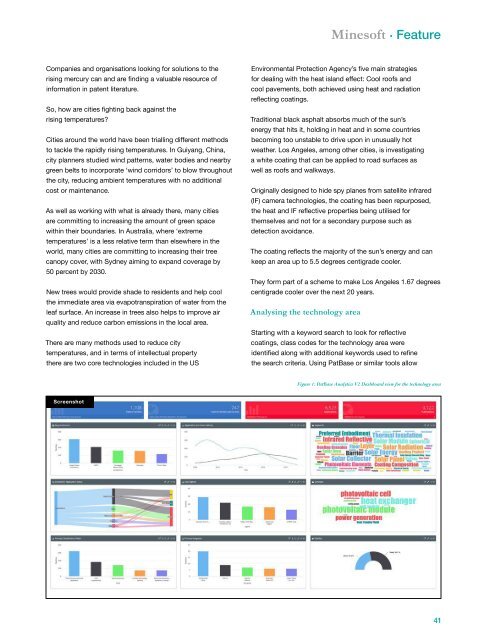IPPro The Annual 2018/19
The beating heart of the world is reaching new heights in innovation, with technology coming to the forefront in 2018 as an enabler of efficiency and automation. In the intellectual property industry, artificial intelligence, machine learning, and blockchain are beginning to shape the burgeoning technology services landscape, and exciting opportunities for both inventors and law firms alike are beginning to present themselves. However recent regulation, such as the EU’s General Data Protection Regulation has drawn a line in the sand for enforcers, resulting in far-reaching consequences across continents, and leaving brands open to attacks from those wanting to hide behind anonymity on the internet. All this, and more, is discussed inside IPPro: The Annual, which features comment and analysis from the world’s leading IP associations. We hope you like its new coat of paint and, as ever, if you have any feedback or suggestions, don’t hesitate to get in touch.
The beating heart of the world is reaching new heights in innovation, with technology coming to the forefront in 2018 as an enabler of efficiency and automation.
In the intellectual property industry, artificial intelligence, machine learning, and blockchain are beginning to shape the burgeoning technology services landscape, and exciting opportunities for both inventors and law firms alike are beginning to present themselves.
However recent regulation, such as the EU’s General Data Protection Regulation has drawn a line in the sand for enforcers, resulting in far-reaching consequences across continents, and leaving brands open to attacks from those wanting to hide behind anonymity on the internet.
All this, and more, is discussed inside IPPro: The Annual, which features comment and analysis from the world’s leading IP associations. We hope you like its new coat of paint and, as ever, if you have any feedback or suggestions, don’t hesitate to get in touch.
Create successful ePaper yourself
Turn your PDF publications into a flip-book with our unique Google optimized e-Paper software.
Minesoft · Feature<br />
Companies and organisations looking for solutions to the<br />
rising mercury can and are finding a valuable resource of<br />
information in patent literature.<br />
So, how are cities fighting back against the<br />
rising temperatures?<br />
Cities around the world have been trialling different methods<br />
to tackle the rapidly rising temperatures. In Guiyang, China,<br />
city planners studied wind patterns, water bodies and nearby<br />
green belts to incorporate ‘wind corridors’ to blow throughout<br />
the city, reducing ambient temperatures with no additional<br />
cost or maintenance.<br />
As well as working with what is already there, many cities<br />
are committing to increasing the amount of green space<br />
within their boundaries. In Australia, where ‘extreme<br />
temperatures’ is a less relative term than elsewhere in the<br />
world, many cities are committing to increasing their tree<br />
canopy cover, with Sydney aiming to expand coverage by<br />
50 percent by 2030.<br />
New trees would provide shade to residents and help cool<br />
the immediate area via evapotranspiration of water from the<br />
leaf surface. An increase in trees also helps to improve air<br />
quality and reduce carbon emissions in the local area.<br />
<strong>The</strong>re are many methods used to reduce city<br />
temperatures, and in terms of intellectual property<br />
there are two core technologies included in the US<br />
Environmental Protection Agency’s five main strategies<br />
for dealing with the heat island effect: Cool roofs and<br />
cool pavements, both achieved using heat and radiation<br />
reflecting coatings.<br />
Traditional black asphalt absorbs much of the sun’s<br />
energy that hits it, holding in heat and in some countries<br />
becoming too unstable to drive upon in unusually hot<br />
weather. Los Angeles, among other cities, is investigating<br />
a white coating that can be applied to road surfaces as<br />
well as roofs and walkways.<br />
Originally designed to hide spy planes from satellite infrared<br />
(IF) camera technologies, the coating has been repurposed,<br />
the heat and IF reflective properties being utilised for<br />
themselves and not for a secondary purpose such as<br />
detection avoidance.<br />
<strong>The</strong> coating reflects the majority of the sun’s energy and can<br />
keep an area up to 5.5 degrees centigrade cooler.<br />
<strong>The</strong>y form part of a scheme to make Los Angeles 1.67 degrees<br />
centigrade cooler over the next 20 years.<br />
Analysing the technology area<br />
Starting with a keyword search to look for reflective<br />
coatings, class codes for the technology area were<br />
identified along with additional keywords used to refine<br />
the search criteria. Using PatBase or similar tools allow<br />
Figure 1: PatBase Analytics V2 Dashboard view for the technology area<br />
Screenshot<br />
41





